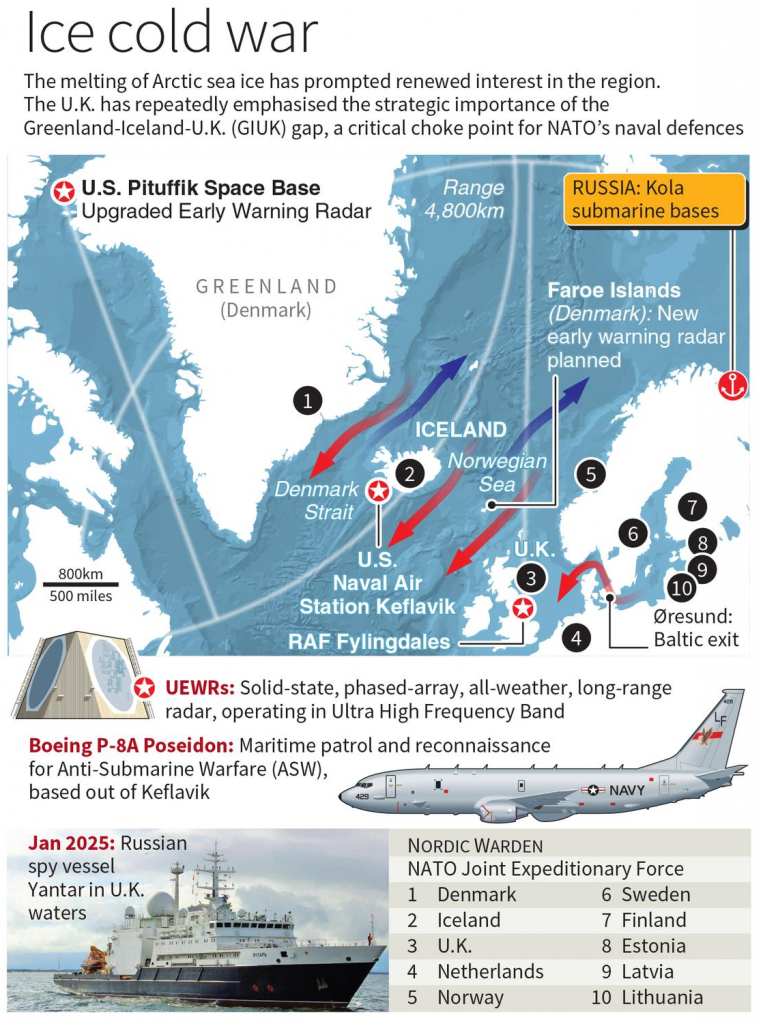Syllabus: GS2/International Relations; GS3/Resource Geography
Context
- The Arctic has become a geopolitical hotspot due to climate change, resource competition, and strategic rivalries among major powers.
About Arctic Region
- It is one of the most fragile and crucial ecosystems on Earth, covering the northernmost parts of the planet.
- It includes the Arctic Ocean, parts of Canada, Russia, Greenland, Norway, Sweden, Finland, Iceland, and the United States (Alaska).
- The Arctic is warming at nearly four times the global average, causing environmental and economic shifts that influence policies and territorial claims.
Key Factors Driving Geopolitical Tensions in Arctic Region
- Natural Resources: According to the U.S. Geological Survey, the region holds about 13% of the world’s undiscovered oil and 30% of its natural gas.
- With ice caps retreating, these resources are becoming increasingly accessible, fueling competition among nations seeking to exploit them.
- New Navigational Routes: These include routes such as the Northern Sea Route (NSR) and the Northwest Passage are becoming viable alternatives to the Suez and Panama Canals.
- The Northeast Passage along Russia’s Arctic coast could shorten trade routes between Asia and Europe by 8,000 km, reducing costs significantly.
- Northwest Passage, a potential shipping route through Canada’s Arctic archipelago, remains a flashpoint.
- Canada asserts it as internal waters, while the US insists it is an international strait with freedom of navigation.
Key Concerns/Challenges
- Russia’s Expansion in the Arctic: Russia, which controls nearly half of the Arctic coastline, has been actively increasing its military presence in the region.
- It has reopened Soviet-era military bases, deployed nuclear-powered icebreakers, and modernized its Arctic military infrastructure.
- Russia conducted regular military drills, signaling its determination to assert control over Arctic waters.
- NATO’s Response and Western Concerns: In response to Russia, the United States and NATO have ramped up their presence in the region.
- Finland and Sweden’s decision to join NATO is partly due to concerns over Russian aggression, particularly after its invasion of Ukraine.
- The US has increased Arctic military exercises, deployed submarines, and strengthened ties with Norway and Canada to counter Russian influence.
- The United Kingdom, for instance, has repeatedly emphasised the strategic importance of the Greenland-Iceland-U.K. (GIUK) gap, a critical choke point for NATO’s naval defences.
- China’s Growing Arctic Ambitions: China, despite being a non-Arctic nation, has declared itself a ‘near-Arctic state’ and is investing heavily in Arctic infrastructure.
- It has proposed a ‘Polar Silk Road’ as part of its Belt and Road Initiative, aiming to establish economic and scientific footholds in the region.
- Legal Disputes and Territorial Claims: Several Arctic nations have competing territorial claims in the region, particularly over the continental shelf.

Geopolitical Implications
- UN Convention on the Law of the Sea (UNCLOS): Nations can extend their claims to the seabed beyond the 200-nautical-mile EEZ if they can prove that the area is a natural prolongation of their continental shelf.
- Russia, Canada, and Denmark (via Greenland) have all submitted claims to extend their seabed sovereignty under the UNCLOS.
- The US, which has not ratified UNCLOS, faces limitations in asserting its claims. Meanwhile, Russia has used legal maneuvers and strategic military positioning to reinforce its claims, challenging Western interests.
- Arctic Council: It is composed of eight nations (U.S., Canada, Russia, Denmark, Norway, Sweden, Finland, and Iceland), and aims to promote environmental protection and scientific cooperation.
- It was formally established in 1996 through the Ottawa Declaration.
- India is an Observer in the Arctic Council.
India’s Role in Arctic Research
- India, despite being a non-Arctic nation, plays an active role in Arctic research.
- National Centre for Polar and Ocean Research (NCPOR): India conducts scientific studies on climate patterns, marine biodiversity, and glacial dynamics.
- India’s Arctic Policy, titled ‘India and the Arctic’ by the Ministry of Earth Science for building a partnership for sustainable development.
- India established Himadri (in 2008), its research station in Svalbard, Norway, to study Arctic climate systems and their global impact.
Previous article
Energy Statistics India 2025
Next article
News In Short-1-04-2025